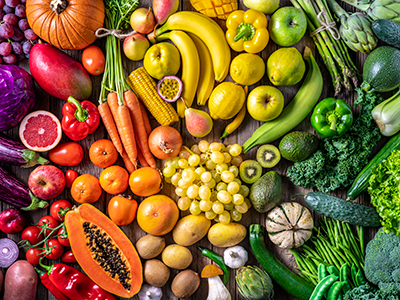You can probably feel it coming: A scratchy throat, a cough that just won’t quit and that tired, achy feeling. Cold and flu season is now arriving in your neighborhood. As a registered dietitian at Children’s National Health System, I work with families every day to guide them toward healthy choices that help children grow up stronger. One of the most common questions parents ask me throughout the winter months is, “How can I keep my children from catching a cold or the flu this season?” While warding off sickness requires a daily commitment to healthy choices beyond just nutrition – such as staying active and exercising, getting enough sleep and washing your hands regularly – eating a well-balanced, colorful diet can also help you avoid common pitfalls.
Here’s some advice for a healthy start to the New Year:
Channel your inner Bobby Flay or Julia Child
By including children in snack and meal prep, choosing healthy foods can be fun. Set up a make-your-own smoothie station for kids to invent new smoothie flavors using low-fat dairy yogurt and their favorite fruits and vegetables. Strawberries are loaded with vitamin C and are easy to grab from the frozen section of the grocery store. Or pretend to be a famous Italian chef, cooking up mini-pizzas made with whole grain English muffins or pita bread, sauce and low-fat cheese. Top with veggies like spinach for vitamin E or red bell pepper slices for vitamin A.
Turn water into a sweet treat
Water is the cornerstone of a healthy immune system. It transports nutrients and oxygen to cells throughout the body, and it carries away waste products and toxins. But getting children to drink the recommended amount of water each day – approximately 5 to 10 cups based on age – can be daunting. Turn up the flavor and make water a sweet treat by freezing strawberries, blueberries and other fruit into ice cubes or using an infuser.
Be on the lookout for these missing colors
Many families don’t have trouble getting enough starchy vegetables such as potatoes and corn, but as the U.S. Department of Agriculture’s MyPlate tool points out, we all need to focus on eating more dark green, red and orange vegetables. These veggies give us fiber, vitamins, minerals and other nutrients to keep our bodies and immune systems healthy. For example, dark green vegetables can provide vitamin K, folic acid, potassium and omega-3 fatty acids. Red and orange vegetables also can be great sources of powerful antioxidants, such as lycopene and beta carotene. Turn capturing these nutrients into an activity by making a veggie skewers workshop and encouraging kids to assemble the most colorful mix of vegetables possible.
Avoid chugging orange juice
Unfortunately, a mega-dose of a nutrient won’t have a magical effect on the immune system. If you don’t have deficiencies, there is no evidence that taking extra amounts of any vitamin will protect you. Instead, take small steps every day to keep your family healthy and make sure you’re getting the recommended servings of fruits and vegetables. It’s likely more enjoyable than chugging orange juice and will help keep your immune system strong.
If you have questions about whether your child is getting the right nutrients, be sure to ask your family’s pediatrician. And for additional kid-friendly ideas, visit EatRight.org by the Academy of Nutrition and Dietetics.
This blog post originally appeared in Northern Virginia Magazine online.
 https://riseandshine.childrensnational.org/wp-content/uploads/2024/10/Healthy-School-Lunch-feature.jpg
300
400
Danielle Robbins
https://riseandshine.childrensnational.org/wp-content/uploads/2017/11/childrens_riseandshine_logo.jpg
Danielle Robbins2024-10-22 12:27:422024-10-22 12:30:29Packing a healthy school lunch
https://riseandshine.childrensnational.org/wp-content/uploads/2024/10/Healthy-School-Lunch-feature.jpg
300
400
Danielle Robbins
https://riseandshine.childrensnational.org/wp-content/uploads/2017/11/childrens_riseandshine_logo.jpg
Danielle Robbins2024-10-22 12:27:422024-10-22 12:30:29Packing a healthy school lunch




















Leave a Comment
Want to join the discussion?Feel free to contribute!